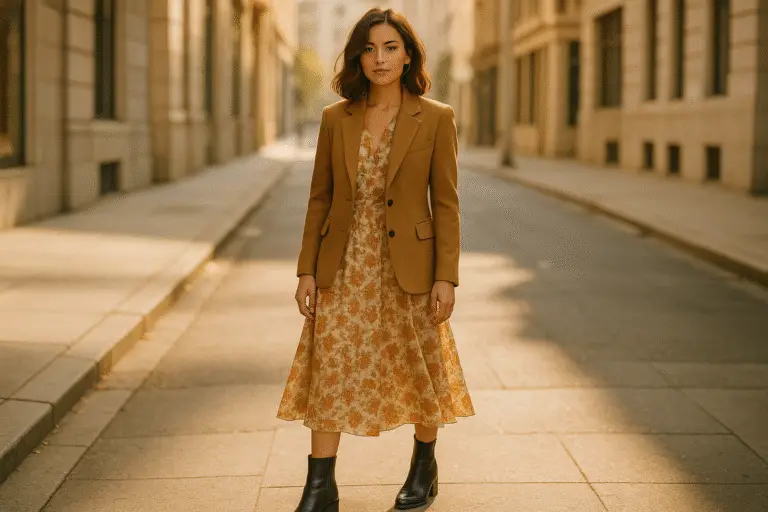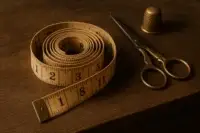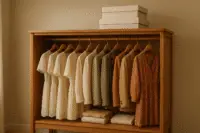Mixing vintage and modern fashion allows you to create personalized, standout outfits while making sustainable wardrobe choices. The key is pairing vintage treasures with modern basics to balance style and functionality. For example, combine a 1970s silk blouse with sleek trousers or update a 1950s circle skirt with a fitted tee and sneakers. Start small with accessories like scarves or belts, then experiment with bolder combinations as you gain confidence.
Quick Tips for Mixing Vintage and Modern:
- Start with a vintage focal point: A jacket, blouse, or accessory.
- Balance with modern essentials: Jeans, sneakers, or tailored blazers.
- Focus on fit: Tailor vintage items to suit current proportions.
- Layer for versatility: Add turtlenecks, tights, or cardigans to vintage pieces.
- Use accessories: Scarves, jewelry, and handbags tie eras together.
Whether you prefer subtle touches or bold statements, blending eras is all about experimenting with what feels right for you. Prioritize comfort and style, and let your wardrobe tell your story.
How to Style Vintage with Modern Clothing
Must-Have Vintage Pieces and Modern Basics
Once you understand the charm of mixing styles from different eras, it’s time to create a wardrobe that blends the best of both worlds. The key is to find standout vintage treasures and pair them with modern essentials that bring balance and versatility.
Top Vintage Pieces for Every Closet
- High-waisted trousers: These gems from mid-20th-century fashion offer a flattering fit and pair beautifully with today’s fitted tops or cropped sweaters. With their higher rise, they create a striking contrast against modern mid-rise jeans and streamlined tops.
- Circle skirts: A 1950s classic, these skirts can be styled with vintage blouses for a retro vibe or modern tees for a fresh twist. Solid wool or cotton versions are especially versatile, and their full silhouette contrasts elegantly with contemporary fitted tops.
- Silk scarves: A timeless accessory, silk scarves from past decades instantly elevate any outfit. For instance, draping one over a basic white button-down and jeans adds a touch of sophistication.
- Vintage leather jackets: Known for their durability and unique patina, vintage leather jackets bring an edgy flair to modern outfits. Whether paired with a midi dress or wide-leg pants, a well-maintained jacket can add character to any look.
- Statement blouses: Look for vintage tops with eye-catching details like balloon sleeves, embroidery, or bold prints. These pieces shine when paired with modern straight-leg jeans or layered under a sleek blazer, blending eras seamlessly.
Modern Wardrobe Basics
- Classic jeans: Straight-leg or slim-fit jeans provide the perfect base for vintage tops. Brands like Levi’s and Everlane offer timeless designs that let ornate vintage pieces take center stage.
- Minimalist white sneakers: Clean sneakers, such as Adidas Stan Smiths, ground vintage outfits in a modern context. They’re versatile enough to make even a classic shift dress feel current.
- Modern blazers: Neutral-colored blazers with contemporary tailoring add structure to vintage outfits. They balance the volume of vintage skirts or trousers and define the waist for a polished look.
- Basic tees and tanks: High-quality, well-fitted tees and tanks are essential for pairing with vintage bottoms. Their clean lines and simplicity make them ideal for tucking into high-waisted trousers or skirts.
- Contemporary accessories: Items like structured handbags, delicate jewelry, and modern sunglasses tie everything together. For example, a sleek crossbody bag can update a vintage dress, while trendy eyewear adds a modern touch. These thoughtful additions ensure your look feels intentional rather than costume-like.
To better understand how these two styles work together, let’s take a closer look at their strengths and challenges.
Vintage vs. Modern: Pros and Cons
| Aspect | Vintage Pieces | Modern Pieces |
|---|---|---|
| Construction Quality | Often showcase superior craftsmanship and durability | Provide consistent sizing and fit |
| Uniqueness | One-of-a-kind with authentic period details | Widely available, designed for broad appeal |
| Cost | Prices vary based on rarity and condition | More predictable pricing |
| Fit Considerations | May need alterations due to outdated sizing | True-to-size with modern proportions |
| Care Requirements | Usually require delicate cleaning or handling | Designed for standard machine washing |
| Versatility | Serve as statement pieces that define a look | Work as neutral building blocks |
Vintage pieces bring personality and artisanal charm, while modern basics provide steady reliability and ease of wear. Together, they create a wardrobe that’s not only stylish but also timeless. For more guidance, AllVintageStyles‘ resources can help you identify authentic vintage finds and pair them confidently with today’s fashion staples.
How to Pair Vintage and Modern Pieces
Blending vintage and modern pieces is all about creating a harmonious look that combines the charm of the past with contemporary style.
Step-by-Step Pairing Methods
Begin with a striking vintage piece as your focal point. Whether it’s a bold jacket, a unique accessory, or a classic dress, let this item set the tone. Then, incorporate modern elements to keep the outfit balanced and fresh – think sleek trousers, minimalist shoes, or a trendy bag. This approach allows the vintage item to shine while ensuring the overall look feels polished and up-to-date. Finally, tweak these combinations to reflect your unique style and personality.
Making It Work for Your Personal Style
Blending vintage and modern styles successfully means shaping your wardrobe to reflect who you are. It’s about tailoring your choices to fit your personality and lifestyle while building on the mix-and-match methods we’ve already discussed.
Finding Your Style Direction
To start, explore different decades to see which vintage eras resonate with you. Maybe you’re drawn to the structured elegance of the 1940s, the bold prints of the 1970s, or the dramatic shoulders of the 1980s. Try on pieces from various time periods and notice what makes you feel both confident and comfortable.
Take a close look at your current wardrobe. If you gravitate toward clean, minimalist designs, vintage items with simple lines – like those from the 1960s – might complement your style better than more ornate options. On the other hand, if you’re into romantic, flowing fabrics, you might feel more at home with delicate, detailed pieces from the 1920s or 1950s.
Your lifestyle also plays a role. For instance, if you work in a corporate setting, you might focus on vintage blazers and tailored pants, pairing them with modern accessories. If you’re in a creative field, you might experiment with vivid vintage prints, mixing them with contemporary denim or sneakers. Whatever your day-to-day looks like, your style direction will help you create balanced, era-blending outfits.
Once you’ve identified the vintage styles that suit you, it’s time to tweak them for modern life.
Adjusting Vintage Pieces for Today
Vintage clothing often benefits from a little updating to fit seamlessly into today’s wardrobe. For example, you could hem a 1970s maxi dress to a midi length for everyday wear or tailor an oversized vintage blazer for a sharper, more current silhouette.
Layering is another way to make vintage work for modern occasions and weather. A sleeveless 1960s shift dress can become winter-ready when paired with a fitted turtleneck, tights, and boots. A delicate vintage blouse gains versatility when layered under a contemporary cardigan or even worn over a modern tank top.
Don’t overlook the importance of small updates to vintage accessories. Swap out broken zippers on vintage purses, add comfortable insoles to vintage shoes, or replace outdated buttons with ones that match your taste. These practical tweaks ensure your vintage finds are not only stylish but also functional.
Color coordination is key to making vintage pieces feel fresh. If you love a vintage pattern but find the original colors too dated, look for similar prints in more modern color palettes. Alternatively, use accessories to bridge the gap between vintage hues and your preferred modern tones.
Building Confidence in Your Style Choices
Confidence in your style comes from wearing what feels right to you, not what fashion rules dictate. Start small by incorporating vintage accents like scarves, belts, or earrings before diving into bolder combinations. This gradual approach can help you get comfortable with mixing eras.
Keep in mind that personal style is fluid. What feels perfect today might evolve as your lifestyle changes or as you discover new vintage treasures. Some days you might prefer subtle vintage touches, while on others you may want to go all in with a bold statement piece.
Forget rigid fashion rules when combining vintage and modern. If you love the idea of pairing a 1950s circle skirt with a graphic tee and sneakers, go for it. Experiment with different ways to style a single vintage piece – like a blazer that works equally well over a modern dress for the office, with jeans and a t-shirt on the weekend, or over a slip dress for evening events. Versatility like this can boost your confidence in investing in vintage items.
Above all, prioritize fit and comfort. If something doesn’t feel right, don’t force it. Adjust it or move on. Your wardrobe should reflect your style naturally, without compromise.
Staying Current: Seasonal Tips and Practical Advice
Successfully blending vintage and modern fashion isn’t just about aesthetics. It’s also about practicality. From weather considerations to event-specific dress codes, this guide will help you navigate how to incorporate vintage pieces into your wardrobe while staying current and comfortable.
Dressing for Seasons and Events
Layering is your best friend when winter hits. A 1960s wool coat pairs effortlessly with modern skinny jeans and ankle boots, offering both warmth and style. Add a vintage scarf to elevate a simple modern sweater or coat. When temperatures plunge below 32°F, lean on vintage staples like wool blazers, leather gloves, and sturdy boots. For example, a vintage wool peacoat combined with modern thermal leggings and waterproof boots strikes the perfect balance between function and flair.
On the flip side, summer calls for breathable, lightweight vintage fabrics. A 1950s cotton sundress looks stunning with modern sandals and a chic sun hat. For casual outings, a 1970s linen shirt works wonderfully with modern shorts and sneakers. When the thermometer climbs above 85°F, prioritize vintage pieces made from natural fabrics like cotton, linen, or silk to stay cool and comfortable.
For formal occasions, vintage evening wear can make a bold statement, especially when paired with modern accessories. Think of a 1960s cocktail dress brought to life with contemporary jewelry and shoes. Or, take a modern black dress and add vintage pearl earrings and a beaded clutch from the 1920s for a timelessly elegant look.
Casual events are a playground for mixing eras. A 1990s band t-shirt paired with modern high-waisted jeans or a 1970s denim jacket layered over a contemporary maxi dress creates effortlessly cool outfits. Farmers markets, casual dinners, and shopping trips are perfect opportunities to experiment with these combinations.
U.S. Fashion and Practical Factors
When it comes to vintage shopping in the U.S., there are a few practical considerations to keep in mind. Vintage sizing often runs smaller than today’s standards, so always check actual measurements rather than relying on the size label, especially when shopping online.
Regional climates also play a big role. In the Southwest, where summer temperatures can soar to 110°F, look for vintage pieces in lightweight fabrics and lighter colors to beat the heat. Meanwhile, in the Northeast, where winter can bring temperatures below 20°F, vintage wool coats and leather boots become wardrobe essentials.
Workplace dress codes vary across the country, so adapt your vintage-modern mix accordingly. In conservative corporate settings, subtle touches like a vintage watch paired with a modern suit or classic 1960s pumps with a contemporary outfit can add a polished edge. Creative workplaces, on the other hand, allow for more adventurous combinations of vintage and modern styles.
Caring for vintage items is another important aspect. Many pieces require special attention, such as dry cleaning or hand washing, which can add to your maintenance costs. Proper storage is also key. Keep delicate fabrics safe from humidity and pests to preserve their quality.
Adding Vintage Accessories to Modern Outfits
Accessories are the easiest way to bring vintage charm into your everyday wardrobe. A silk scarf from the 1970s, for example, can be styled in multiple ways – tied around your neck, worn as a headband, or even used as a belt with modern jeans and a plain t-shirt. Larger scarves can double as wraps over sleeveless modern dresses for evening events.
Vintage handbags add character to any outfit. A structured 1960s handbag can elevate a casual sweater-and-jeans combo, while an elegant 1980s clutch serves as the perfect accent for modern cocktail dresses. When selecting vintage bags, always check that the hardware is functional and the interior is clean.
Jewelry is another simple yet impactful way to merge eras. Bold 1980s statement earrings can transform a minimalist modern dress, while delicate 1920s brooches bring sophistication to a contemporary blazer. Vintage watches from the 1970s or 1980s are both stylish and practical, making them a versatile addition to any outfit.
Belts are a great tool for defining your silhouette. A wide belt from the 1970s can cinch an oversized modern tunic, while a narrow vintage belt pairs beautifully with high-waisted jeans or layered over cardigans and dresses.
Finally, vintage shoes can ground your outfits, but comfort and condition are key. Opt for well-maintained boots or heels that offer support, and steer clear of pairs with worn-out soles or those that feel uncomfortable. To keep your accessories fresh, rotate them seasonally. For instance, store delicate silk scarves during humid summers and bring out sturdier wool pieces for the colder months. This thoughtful approach ensures your wardrobe stays stylish and functional year-round.
Conclusion: Getting Good at Mixing Fashion Eras
Blending vintage and modern fashion is all about finding balance, building confidence, and practicing your style experiments. The principles we’ve discussed – like understanding proportions, playing with textures, and adapting outfits for different seasons or occasions – offer a strong starting point for creating looks that feel both personal and timeless. These guidelines help you craft outfits that seamlessly combine the charm of vintage with the ease of modern trends.
Start small if you’re new to mixing eras. For instance, try adding a vintage scarf or bag to an otherwise modern outfit. Once you’re comfortable, take it up a notch – pair a 1970s blazer with skinny jeans or layer bold, vintage jewelry over sleek, minimalist clothing.
Fit and proportion are key when combining styles from different decades. A tailored vintage piece will always outshine something that doesn’t suit your body, no matter how trendy it is. Simple alterations, like hemming a 1960s dress or adjusting the waist of an oversized 1980s blazer, can elevate a piece from just “okay” to absolutely stunning. This attention to detail ensures your outfits feel polished, no matter how daring your combinations might be. Whether you prefer subtle vintage accents in a modern wardrobe or love making bold statements with standout retro pieces, there’s no right or wrong way to approach this creative style.
As you refine your vintage-modern mix, let your instincts guide you and enjoy the process. Fashion is meant to be fun, and the endless combinations of past and present ensure your style will always feel fresh and exciting. Each outfit becomes a story – one that’s uniquely yours.
FAQs
How can I make sure vintage clothing fits well with modern sizes?
When shopping for vintage clothing, it’s best to focus on your body measurements rather than the size labels. Sizing standards have shifted over the years, and vintage sizes often run smaller than modern ones. To get the right fit, compare your bust, waist, and hip measurements (in inches) to the garment’s listed dimensions.
As a general guideline, vintage sizes are usually a few numbers smaller than today’s sizing. For instance, a vintage size 10 might be closer to a modern size 4 or 6. But don’t rely solely on labels. Measurements are the key to avoiding surprises and finding pieces that fit your style perfectly.
What are the best ways to care for vintage clothing and keep them in great condition?
To keep your vintage clothing in great shape, gentle care makes all the difference. Whenever you can, hand-wash these items in cold water using a mild detergent. Be careful not to wring or scrub them, as this can harm delicate fabrics. For especially fragile pieces, it’s a good idea to take them to a professional cleaner who specializes in vintage garments.
When it comes to storage, choose a cool, dry, and dark spot to shield your pieces from moisture, light, and dust. Acid-free tissue paper and archival storage boxes are excellent for preserving their condition. After washing, lay the items flat on a clean towel to dry, keeping them out of direct sunlight to protect their colors and fabric quality.
With these care tips, your vintage finds will stay beautiful and timeless for years to come!
How can I choose vintage pieces that work with my personal style and wardrobe?
To seamlessly incorporate vintage pieces into your wardrobe, start by taking a closer look at what you already own. Pinpoint your go-to items and note their colors, patterns, and silhouettes. Then, seek out vintage clothing or accessories that align with these elements – whether you lean toward neutral tones for everyday wear or bold patterns to make a statement.
When it comes to styling, balance is everything. Mix vintage with modern essentials, like pairing a 1950s skirt with a sleek, contemporary blouse or teaming a vintage jacket with your favorite pair of jeans. Accessories can also work wonders – think vintage jewelry, handbags, or shoes to add a retro flair without overwhelming your outfit. The goal is to merge the old and the new, creating a look that’s polished and distinctly your own.



